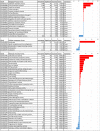Differential expression of genes associated with non-target site resistance in Poa annua with target site resistance to acetolactate synthase inhibitors
- PMID: 34218510
- PMCID: PMC8518846
- DOI: 10.1002/ps.6541
Differential expression of genes associated with non-target site resistance in Poa annua with target site resistance to acetolactate synthase inhibitors
Abstract
Background: Poa annua is a pervasive grassy, self-pollinating, weed that has evolved resistance to 10 different herbicide modes-of-action, third most of all weed species. We investigated constitutive overexpression of genes associated with non-target site resistance (NTSR) in POAAN-R3 and the response of those genes when treated with trifloxysulfuron despite the biotype having a known target site mutation in acetolactate synthase (ALS).
Results: Despite having an ALS target site mutation, POAAN-R3 still had a transcriptomic response to herbicide application that differed from a susceptible biotype. We observed differential expression of genes associated with transmembrane transport and oxidation-reduction activities, with differences being most pronounced prior to herbicide treatment.
Conclusions: In the P. annua biotype we studied with confirmed target site resistance to ALS inhibitors, we also observed constitutive expression of genes regulating transmembrane transport, as well as differential expression of genes associated with oxidative stress after treatment with trifloxysulfuron. This accumulation of mechanisms, in addition to the manifestation of target site resistance, could potentially increase the chance of survival when plants are challenged by different modes of action.
Keywords: RNA-Seq; non-target site resistance; transcriptomics; turfgrass.
© 2021 The Authors. Pest Management Science published by John Wiley & Sons Ltd on behalf of Society of Chemical Industry.
Figures




Similar articles
-
Utilizing next-generation sequencing to study homeologous polymorphisms and herbicide-resistance-endowing mutations in Poa annua acetolactate synthase genes.Pest Manag Sci. 2015 Aug;71(8):1141-8. doi: 10.1002/ps.3897. Epub 2014 Sep 25. Pest Manag Sci. 2015. PMID: 25180862
-
A new amino acid substitution (Ala-205-Phe) in acetolactate synthase (ALS) confers broad spectrum resistance to ALS-inhibiting herbicides.Planta. 2016 Jan;243(1):149-59. doi: 10.1007/s00425-015-2399-9. Epub 2015 Sep 9. Planta. 2016. PMID: 26353912 Free PMC article.
-
Cross and multiple herbicide resistance in annual bluegrass (Poa annua) populations from eastern Texas golf courses.Pest Manag Sci. 2021 Apr;77(4):1903-1914. doi: 10.1002/ps.6217. Epub 2020 Dec 29. Pest Manag Sci. 2021. PMID: 33284481
-
Resistance to AHAS inhibitor herbicides: current understanding.Pest Manag Sci. 2014 Sep;70(9):1340-50. doi: 10.1002/ps.3710. Epub 2014 Jan 20. Pest Manag Sci. 2014. PMID: 24338926 Review.
-
Optimizing RNA-seq studies to investigate herbicide resistance.Pest Manag Sci. 2018 Oct;74(10):2260-2264. doi: 10.1002/ps.4822. Epub 2018 Feb 16. Pest Manag Sci. 2018. PMID: 29222921 Review.
Cited by
-
Weed biology and management in the multi-omics era: Progress and perspectives.Plant Commun. 2024 Apr 8;5(4):100816. doi: 10.1016/j.xplc.2024.100816. Epub 2024 Jan 12. Plant Commun. 2024. PMID: 38219012 Free PMC article. Review.
-
Comprehensive insights into herbicide resistance mechanisms in weeds: a synergistic integration of transcriptomic and metabolomic analyses.Front Plant Sci. 2023 Oct 11;14:1280118. doi: 10.3389/fpls.2023.1280118. eCollection 2023. Front Plant Sci. 2023. PMID: 37885667 Free PMC article. Review.
-
Transcriptome Analysis Reveals the Response Mechanism of Digitaria sanguinalis, Arabidopsis thaliana and Poa annua under 4,8-Dihydroxy-1-tetralone Treatment.Plants (Basel). 2023 Jul 22;12(14):2728. doi: 10.3390/plants12142728. Plants (Basel). 2023. PMID: 37514341 Free PMC article.
-
Comparative genome-wide analysis of circular RNAs in Brassica napus L.: target-site versus non-target-site resistance to herbicide stress.Theor Appl Genet. 2024 Jul 5;137(7):176. doi: 10.1007/s00122-024-04678-x. Theor Appl Genet. 2024. PMID: 38969812
References
-
- Heap I, Global perspective of herbicide‐resistant weeds. Pest Manag Sci 70:1306–1315 (2014). - PubMed
-
- Tardif FJ and Powles SB, Herbicide multiple‐resistance in a Lolium rigidum biotype is endowed by multiple mechanisms: isolation of a subset with resistant acetyl‐CoA carboxylase. Physiol Plant 91:488–494 (1994).
-
- Han H, Yu Q, Owen MJ, Cawthray GR and Powles SB, Widespread occurrence of both metabolic and target‐site herbicide resistance mechanisms in Lolium rigidum populations. Pest Manag Sci 72:255–263 (2016). - PubMed
-
- Chen J, Chu Z, Han H, Goggin DE, Yu Q, Sayer C et al., A Val‐202‐Phe alpha‐tubulin mutation and enhanced metabolism confer dinitroaniline resistance in a single Lolium rigidum population. Pest Manag Sci 76:645–652 (2019). - PubMed
MeSH terms
Substances
Grants and funding
LinkOut - more resources
Full Text Sources
Miscellaneous

